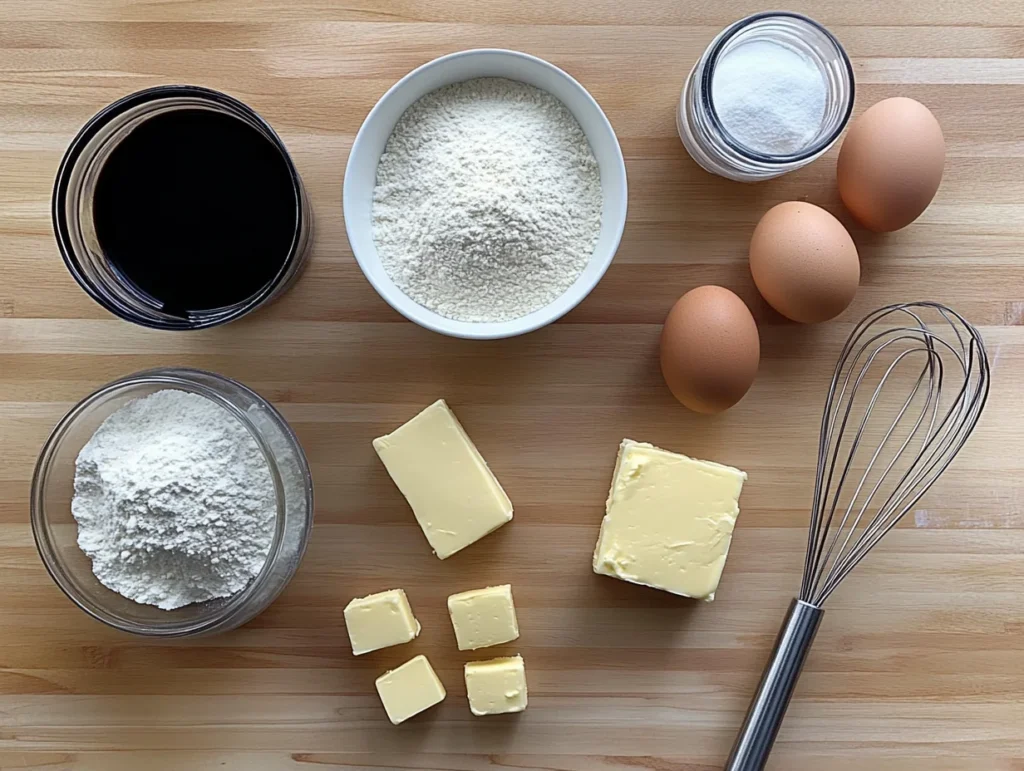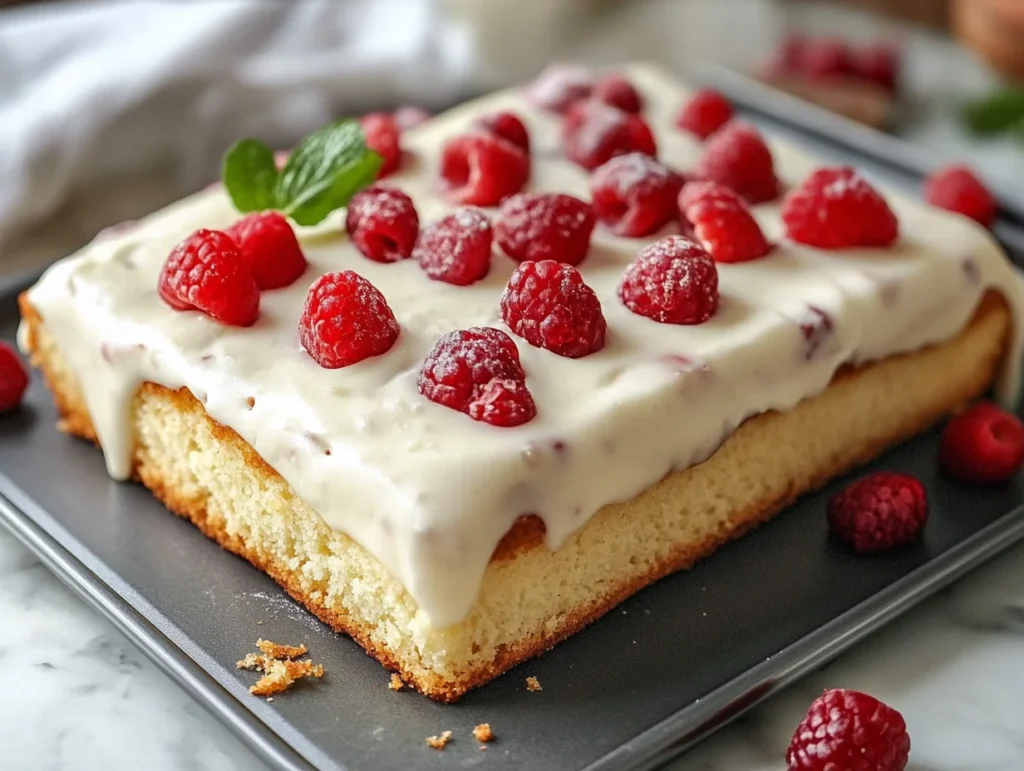Sheet cakes are the unsung heroes of the dessert world, often spotted in bakery displays or party spreads. They are baked in rectangular pans, which provide their signature shape and make them perfect for serving a crowd. Whether you’re an experienced baker or a beginner, understanding the right tools and techniques is key to achieving the perfect sheet cake. This guide will help you master everything from choosing the pan to troubleshooting baking challenges, so let’s get started!
Introduction to Sheet Cakes
Definition of Sheet Cakes
A sheet cake is a single-layer dessert baked in a flat rectangular pan, making it an excellent choice for feeding a crowd. Its straightforward design and practical shape make it easy to prepare, transport, and serve, making it a staple for gatherings of all kinds. The simplicity of a sheet cake doesn’t mean it lacks appeal; its versatility allows for endless flavor combinations, frostings, and decorations to suit any occasion. Whether you’re hosting a casual potluck, celebrating a birthday, or organizing a grand event, a sheet cake consistently delivers on taste and convenience. Its ease of preparation makes it ideal for both novice bakers and seasoned pros, while its ability to adapt to any theme or style ensures it always impresses. No matter the occasion, a well-made sheet cake is a crowd-pleaser that brings joy to every bite.
Popularity of Sheet Cakes
Why are sheet cakes so popular? Well, for starters, they’re practical. Their large surface area makes them perfect for intricate designs or personalized messages. Plus, they’re much easier to cut and serve than traditional layered cakes. Not to mention, they’re incredibly budget-friendly, which makes them a favorite for parties, weddings, and corporate events. Who doesn’t love dessert that’s easy on the wallet and delicious?
“Sheet cakes are the MVP of desserts—always ready to save the day with their simplicity and charm.”
Understanding Sheet Cake Pans
What Are Sheet Cake Pans?
Sheet cake pans are specially designed to bake the signature flat, rectangular cakes we all know and love. They’re typically shallow, which ensures even baking. These pans come in various materials, including aluminum, stainless steel, and even silicone. Each material has its pros and cons, which we’ll dive into shortly.
Common Materials Used in Sheet Cake Pans
Not all pans are created equal! Here’s a quick breakdown of the most common materials and their features:
- Aluminum: The top choice for most bakers. It’s lightweight, conducts heat well, and ensures even baking. However, it can be prone to scratches.
- Stainless Steel: Durable and long-lasting, but it doesn’t conduct heat as efficiently as aluminum, which could lead to uneven baking.
- Silicone: Great for non-stick properties and easy cleanup, but it lacks the rigidity needed for consistent results.
Each of these materials offers unique benefits, so the choice depends on your baking needs and preferences.
Standard Sizes of Sheet Cake Pans
Sheet cake pans come in three standard sizes:
- Quarter Sheet: Perfect for small gatherings, it’s roughly 9 x 13 inches.
- Half Sheet: The most common size, ideal for medium-sized events, measuring about 13 x 18 inches.
- Full Sheet: The granddaddy of sheet pans, designed for large-scale events, typically 18 x 26 inches.

Choosing the right size depends on how many mouths you’re planning to feed. For reference, a half-sheet cake can serve about 40 people, depending on portion sizes.
Choosing the Right Pan for Your Sheet Cake
Factors to Consider When Selecting a Pan
Picking the right pan isn’t as simple as grabbing the first one you see. Here are a few things to think about:
- Material: As we discussed earlier, materials impact baking quality.
- Size: Match the pan size to the number of servings you need.
- Depth: A deeper pan may require adjustments to baking time.
- Coating: Non-stick pans can make your life easier, but they may require gentler handling.
H3: How Pan Material Affects Baking Results
Did you know that the type of pan you use can make or break your sheet cake? For example:
- Aluminum pans heat up quickly and bake evenly, making them perfect for cakes with consistent textures.
- Glass pans retain heat longer, which can cause overbrowning if you’re not careful.
- Dark-colored pans absorb more heat, which might lead to a darker crust. If you’re using one, lower your oven temperature by 25°F to avoid overbaking.
Comparing Non-Stick vs. Aluminum Pans
So, should you go for a non-stick pan or a classic aluminum one? Let’s break it down:
- Non-Stick: Great for easy cleanup, but they may wear out over time. Avoid using metal utensils to prevent scratching.
- Aluminum: A baker’s favorite for consistent results, but you’ll need to grease and line the pan to prevent sticking.
Both options have their merits, but if you’re serious about baking, investing in a high-quality aluminum pan is the way to go.
Common Problems When Baking Sheet Cakes
Uneven Baking
One of the most frustrating issues when baking sheet cakes is uneven baking. You might end up with a cake that’s cooked on the edges but raw in the middle. Why does this happen? Usually, it’s due to uneven heat distribution or using a pan that’s too deep.
Overbrowning of Edges
Have you ever noticed the edges of your cake turning a little too golden? This is often caused by high oven temperatures or using a dark-colored pan. While a slightly crispy edge can be delightful, you don’t want it to overshadow the cake’s soft interior.
Cake Sticking to the Pan
There’s nothing worse than spending hours baking only to have your cake stick to the pan. This problem usually stems from insufficient greasing or not lining the pan properly. Silicone pans can help with this issue, but they’re not foolproof.
“A stuck cake can ruin your day—and your dessert table. A little prep work goes a long way!”
Solutions to Common Baking Problems
Using Parchment Paper for Easy Release
One of the simplest ways to avoid a sticky situation is to use parchment paper. Line your pan with it, and your cake will slide out effortlessly. Plus, it makes cleanup a breeze—who doesn’t love that?
Adjusting Oven Temperature for Even Cooking
If you’ve been struggling with uneven baking, the root cause might be your oven. Many ovens can have temperature fluctuations or inaccurate settings that lead to inconsistent results. To address this, consider investing in an oven thermometer to verify that the temperature inside matches the setting on your dial. Even small discrepancies can make a big difference when baking. Additionally, experimenting with baking at a slightly lower temperature, such as 325°F instead of the typical 350°F, can help. Lower temperatures allow the heat to distribute more evenly, ensuring the cake bakes uniformly without drying out or overcooking the edges. Taking these extra steps will significantly improve your baking results, giving you beautifully even cakes every time.
Greasing and Preparing Your Pan Properly
Even with non-stick pans, a little extra greasing can make all the difference. Use butter, shortening, or a baking spray to coat the pan, and don’t forget the corners! If you’re using parchment paper, grease the pan first to help the paper stick.
Alternatives to Traditional Sheet Cake Pans
Glass vs. Metal Pans
While metal pans are the gold standard for baking sheet cakes, glass pans can also work. However, glass doesn’t conduct heat as efficiently, so your baking times may need adjustment. Keep an eye on the cake to avoid overbrowning.
Silicone Baking Trays
Silicone trays are gaining popularity for their flexibility and non-stick properties. They’re perfect for beginner bakers but may not provide the same level of even heating as metal pans. Use them for small sheet cakes or experimental recipes.
Disposable Aluminum Pans
Hosting a party and don’t want to deal with dishes? Disposable aluminum pans are a convenient option. They’re lightweight and affordable, making them perfect for potlucks or bake sales. Just be cautious when handling them, as they’re not as sturdy as traditional pans.
Decorating and Serving Sheet Cakes
Techniques for Even Frosting
Getting that perfectly smooth frosting isn’t as hard as it seems. Start with a crumb coat—a thin layer of frosting to trap any loose crumbs. Chill the cake for 15 minutes, then apply the final layer of frosting. Use a bench scraper or an offset spatula for a professional finish.
Cutting and Serving Tips
Want neat, bakery-style slices? Use a sharp knife dipped in hot water, wiping it clean between cuts. For large gatherings, pre-score the cake before serving to ensure even portions.
Creative Ways to Decorate Sheet Cakes
Sheet cakes offer a blank canvas for creativity. Use piping bags to create borders, flowers, or fun designs. Add edible glitter, fresh fruit, or even themed toppers for special occasions. The possibilities are endless!
“Your sheet cake is like a canvas—let your imagination run wild and create a masterpiece!”
FAQs
What does kefir do in baking?
Kefir adds moisture and tanginess to baked goods, enhancing their flavor and texture. It also acts as a natural leavening agent when combined with baking soda, resulting in a tender crumb.
Can I use kefir instead of yogurt in cake?
Yes, kefir can be used as a substitute for yogurt in cakes, providing a similar tangy flavor and creamy consistency.
Can I use kefir instead of buttermilk in cake?
Yes, kefir is an excellent substitute for buttermilk in cake recipes, offering the same acidity needed for leavening and a rich, moist texture.

kefir sheet cake recipe
A kefir sheet cake is a simple, moist, and flavorful dessert perfect for any occasion. Kefir adds a tangy richness to the cake, enhancing its taste and texture. It also acts as a natural leavening agent, ensuring a tender crumb. This versatile recipe is easy to prepare and delivers consistently delicious results.
Conclusion:
Sheet cakes are a versatile and crowd-pleasing dessert that can be enjoyed for any occasion, from casual family dinners to festive celebrations. They are beloved not only for their simplicity but also for their ability to feed a large group with minimal effort. One of the great advantages of sheet cakes is their adaptability; you can experiment with countless flavors, fillings, and toppings to suit your preferences or match the theme of your event. Choosing the right pan is crucial for achieving even baking, as it ensures the cake cooks uniformly without overcooking the edges or leaving the center underdone. It’s also essential to address common baking issues, such as accurately measuring ingredients, properly preheating your oven, and checking your cake for doneness at the right time to avoid mishaps.
Once your sheet cake is perfectly baked, the creative possibilities truly begin. From spreading a simple layer of buttercream to creating intricate designs with fondant or fresh fruit, decorating your cake allows you to showcase your style and celebrate the occasion. Classic options like vanilla or chocolate are always a hit, but don’t hesitate to explore bold flavor combinations, such as citrus with cream cheese frosting or mocha with espresso drizzle. Sheet cakes are also perfect for experimenting with different textures, adding layers of crunch with nuts or a drizzle of caramel or ganache. Whether you’re keeping it minimal or going all-out with decorations, a beautifully crafted sheet cake is guaranteed to steal the show. So grab your apron, pick your favorite recipe, and start creating a masterpiece that’s not just delicious but also a delight to share!